
|

|
Two articles in the 15 March 1997 issue of New Scientist describe studies dealing with learning and cognitive abilities in kids. The first article summarizes a study by Dutch researchers who compared the amount of information that kids (aged 10 or 12) retained following video as opposed to print presentation of similar children's news stories. The TV group answered 51% of follow-up questions correctly; the print group got 42% correct. The results were consistent regardless of whether the material was boring or interesting or whether the kids knew that a quiz was part of the process. Measurement of long-term retention was not part of the study. Previous studies have shown that adults absorb information better via print than via TV, but this study doesn't necessarily support the hypothesis of a new video-centric generation because these kids still have a ways to go in perfecting their reading skills. But the study can help delimit where and when video presentation can be constructive in a child's development. The complete research findings appear in the March 1997 issue of the Journal of Educational Psychology. The second article describes a study that documented a 34% improvement in spatial-temporal cognitive skills in 3- and 4-year-olds following six months of piano lessons. Singing lessons and computer lessons had no similar effect. Spatial-temporal skills are important in pattern recognition and pattern comparison skills, which, in turn, are important in mathematical and scientific reasoning. Gordon Shaw and Frances Rauscher conducted the study at the University of California at Irvine, and the complete findings appear in the March 1997 issue of Neurological Research. Earlier research by the two indicated that simply listening to a Mozart sonata (compared to listening to minimalist music or complete silence) could improve pattern prediction performance in specific tasks. The demand for constant innovation in the business environment is creating a dramatic shortage of qualified, creative workers. Companies are going crazy competing for the limited supply of workers capable of creating, managing, and working with and within complex systems. At the same time, the scope of the educational process in public schools is shrinking as schools get back to basics at the expense of sport, music, and art programs. At what point (and at whose instigation) does the pendulum begin to swing back in the opposite direction toward more comprehensive curricula incorporating a well-rounded collection of diverse disciplines that will foster a variety of important cognitive skills?
For more information
Neural Nets for Process Control If you hadn't noticed, sensor technology is getting pretty good these days and a lot cheaper than it used to be. That's causing problems for some folks. In order to optimize the energy inputs in their steel-making process, engineers at the St. Paul plant of North Star Steel Corp. have installed four separate energy-related subsystems to control the electric arc, the gas burners, the carbon input, and the oxygen input on their furnaces. More than 200 sensors in the systems generate as many as 3,600 samples per second. That's a lot of data, and the fact that it exists in four separate systems complicates the process of using it to fine-tune the steel-making process. During 1996, North Star worked with Neural Applications Corp. of Coralville, Iowa, to develop The Intelligent Total Energy Controller, an intelligent-systems solution based on neural-network modeling techniques. The resulting system processes input data and provides feedback to the subsystems three times every second for constant adjustment of the process. The neural-net capabilities of the system allow adaptive data mining that integrates the four subsystems, which have traditionally been controlled separately. As sensors become increasingly cheap and practical, they'll start showing up everywhere. Intelligent-systems technology involving not only neural nets but also fuzzy logic, genetic algorithms, and expert systems will become increasingly important for integrating and interpreting the resulting floods of data.
For more information EET's Smart-Technology SIG As long as we're talking about intelligent systems (the editors at the Electronic Engineering Times refer to them as smart technology), if you need a little background info or if you're looking for the latest developments in the field, EET's Smart-Technology SIG site is a great resource. EET's take on smart technologies breaks them down into five disciplines: neural networks, fuzzy logic, genetic algorithms, artificial life, and virtual reality. (If you're interested in virtual reality, be sure to check out Linda Jacobson's Immersion Quest.) EET's SIG site index presents the user with five categories. What's Hot lists links to articles on recently breaking news. Milestones presents links to past articles chronologically or by discipline. Players lists industry participants alphabetically or by discipline. Catching Up provides links to tutorials in neural networks, fuzzy logic, genetic algorithms, and virtual reality as well as profiles of major researchers in each of those areas. Demos provides links to a variety of Web sites that provide demonstrations or are coordinating the execution of networked systems such as artificial ecologies. |
needtoknow said: Some companies are experimenting with combining changing price lists with corporate email showing customer/prospect requests. They could also be combined with projects up for bid from publications like Commerce Business Daily (for government projects) and onsale.com and other Web-based transactional services. Most Active Topics: Topic 1 Conference Business Topic 3 Conference Introductions Topic 23 Pliny Fisk's Resource Tracking DB | ||||||||||
| |||||||||||
Also in Tech Scan: Learning and Cognition Chemistry Lab on a Microchip DNA Arrays | |||||||||||

